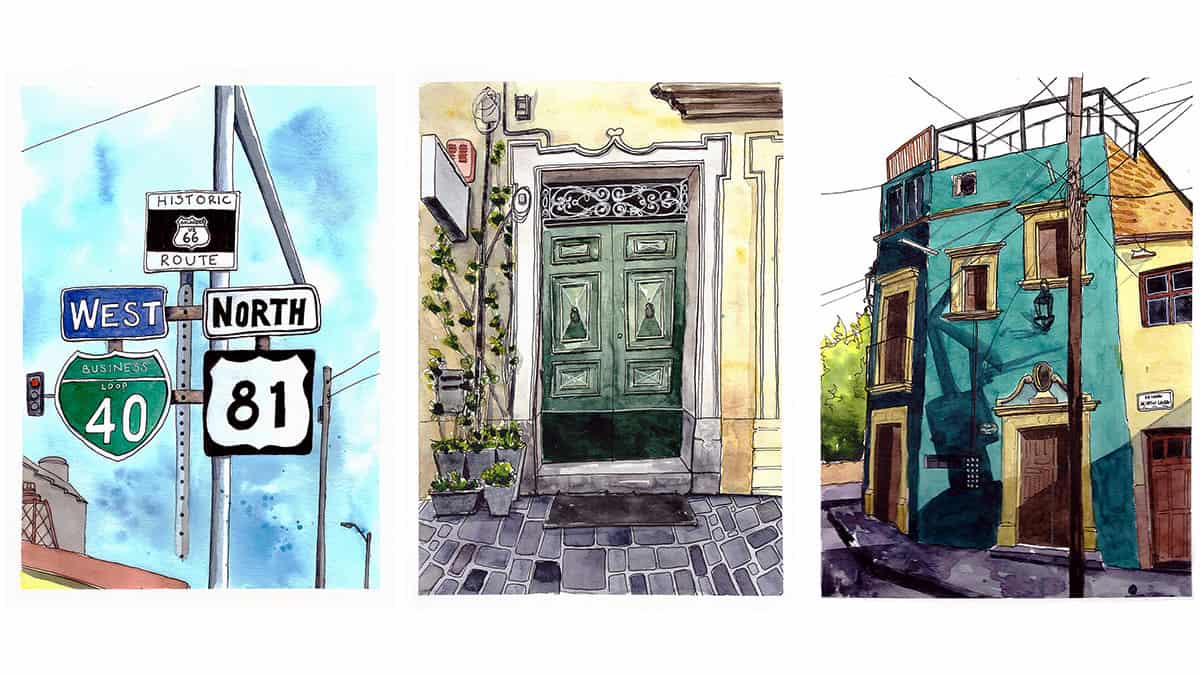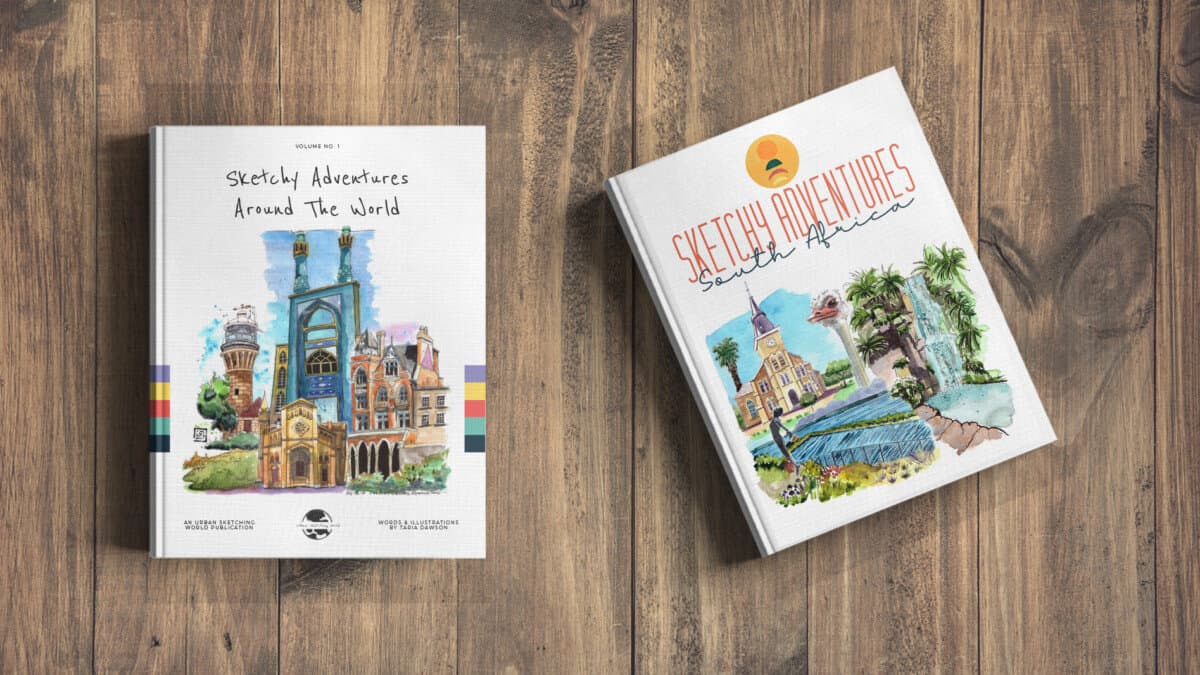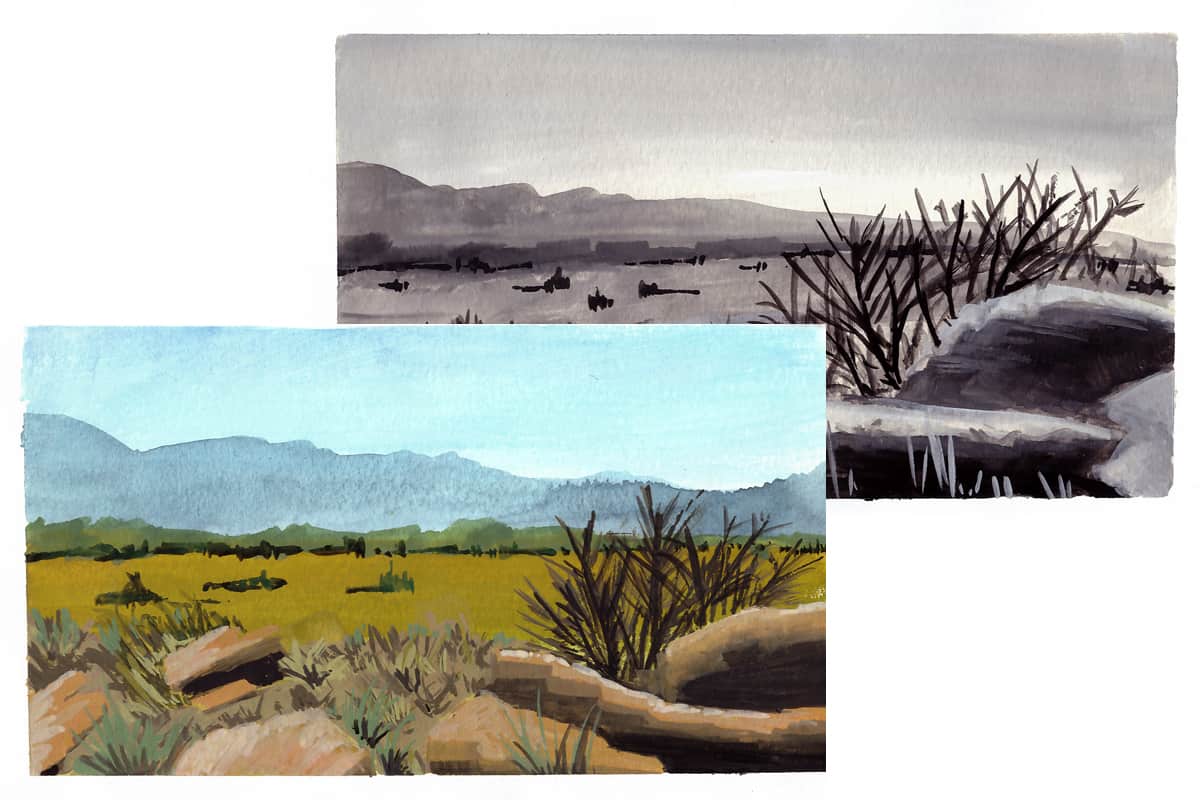As you have probably noticed, most urban sketchers seem to use ink and watercolour for their on-location sketches. The reason for this is predominantly because it is convenient. Watercolour paints are fairly low maintenance. Pull out your paints, get a brush and a little pot of water and off you go. If you have a water brush (the brush that can store water in its handle that when squeezed releases it) even better! It is a very easy and portable setup.
Of course, there are urban sketchers who like to use other mediums. Some just use pen and ink, some use markers (which you can read more about in this post), some use colour pencils, watercolour pencils, pastels etc. I do not often see urban sketchers using gouache though. Perhaps occasionally a bit of white gouache for highlights at the end of a sketch but that’s about it.
Undoubtedly one of the most high profile Youtube artists who uses gouache out on location is James Gurney. I see James as a hybrid between an urban sketcher and a plein-air painter. The reason for this is because he does sketch whatever is at hand and like to record life around him, especially seemingly mundane scenes. He doesn’t search for the perfect scene that will make a beautiful painting like a plein-air painter tends to. However, he usually paints using an easel, with a light reflection umbrella over him, and has a fair bit of kit. Perhaps this is because of filming his Youtube videos but it just speaks more of a plein-air painting setup.
Either way, to be honest, it doesn’t really matter.
I bring it up because, for the casual urban sketcher who likes to whip out their sketchbook at a moments notice, gouache perhaps is not the best medium. It takes a bit more organisation and some more preparation than pulling out a box of watercolours.
Let’s take a deeper dive into exactly what you need to know about sketching on location with gouache.
What is Gouache?
Gouache is a hybrid that falls somewhere between watercolour and acrylic paint. Gouache is opaque, so you can paint light colours on top of dark colours like you can with acrylic paint. However, by adding water gouache works equally well and becomes translucent like watercolour.
Which brand of gouache should I buy?
I would recommend you buy tubes of gouache rather than the dry pans of gouache that are available. I use Winsor & Newton predominantly because that’s all I can get here in South Africa but they are an excellent choice. I think it’s worthwhile investing in a brand such as this rather than cheaper brands such as Reeves. It’s a false economy buying super cheap art materials and the cheap gouache will just not behave as it should and won’t be as pigmented either.
James Gurney uses the brand M.Graham and he has also mentioned Holbein favourably before too. I have seen some Youtube artists use Arteza gouache as well which is probably the best more affordable option, especially if you just want to mess around.
Do you want to learn how to sketch your own adventures in ink & watercolour?
GET 50% OFF FOR A LIMITED TIME ONLY!!
I will show you my exact sketching process in ink and watercolour. I have travelled around the world in the last 3 years and this is my go-to system of creating beautiful yet quirky illustrations to capture the magic of my discoveries.
We will work through 3 projects, step by step (pictured below), all of which are real-life examples of things I have sketched along my travels. I provide the photo references you can work from.
We will start by choosing a composition, laying in the initial pencil sketch, adding ink lines, layering watercolour and adding the final touches.
This and much more are included in my course, Sketch Your Adventures, click the button under the image to find out more!

How Many Colours / Which Colours?
I recommend you start with a small set of colours. I just recently bought the ‘CMYK’ set of Winsor & Newton gouache. This set comes with white, black, yellow, red and blue. To be honest, I have to do a lot of mixing to get the colours I need and I feel like I am getting through too much paint. A slightly larger set with green, brown and yellow ochre would probably be most convenient. This ‘introductory’ set by Winsor & Newton is a great option.
Of course, this depends on what you want to paint. I am speaking with urban sketching in mind, however, if you are doing brighter or imaginative illustrations perhaps your colour selection will need to be a little different.
Can you use watercolour and gouache interchangeably?
Yes, you can use gouache and watercolour together and interchangeably. By using watercolour straight from the tube, it too can have more of an opaque quality. When mixed with gouache it becomes fully opaque so you can use colours interchangeably from your watercolour and gouache collection.
This is actually pretty convenient as it means you don’t need to have a huge set of gouache paints. If you check out some of James Gurney’s videos you will see he tends to use 3-5 tubes of colour for a painting, some of the tubes will have gouache written on them and others will have watercolour written on them.
In the video below James Gurney gives a super quick demo of how he paints with both watercolour and gouache in the same painting.
What Do You Need for Urban Sketching with Gouache?
Brushes
Once you have your gouache paint, you also need brushes. You can use your normal watercolour brushes with gouache and you can also use brushes designed for acrylic. Standard synthetic brushes will be absolutely fine.
I have noticed that many sketchers who work with gouache tend to use flat brushes, they also tend to use a larger brush so that they keep their painting loose and do not get caught up in the details.
It depends on the size of surface you are painting on but a ¼ inch flat brush and then a small round brush for details should be all you need to carry with you.
Some of my favourite online classes
- Gouache Painting of Urban Landscapes – Tommy Kim
- Pictorial Sketchbook with Gouache – Maru Godas
- The Art of Sketching: Transform Your Doodles into Art – Mattias Adolfsson
- Urban Sketching: Express Your World in a New Perspective – Lapin
Sketchbook/Paper
Gouache works well with a watercolour sketchbook that you may already have or carry around with you. It also works well on smoother mixed media paper. Any sketchbook with heavyweight paper is fine.
Palette
Gouache can dry out on your palette, similarly to acrylic paint. Although gouache is generally easier to reactivate. It’s best to have a larger surface to mix on so a dedicated gouache palette is probably going to be the most convenient route.
You can get ‘stay wet’ palettes which, as the name suggests, keeps the paint wet so that it doesn’t dry out and become unusable. The palettehas an air-tight seal and usually contains some kind of damp sponge surface inside to keep moisture locked in. Here’s a popular example of such a palette which you can buy from Amazon.
By looking at this palette is may have crossed your mind that it looks like a simple gadget, it is, and yes you can certainly make your own version at home using a tupperware or other airtight container and placing a damp sponge cut to the correct size at the bottom with some baking paper or grease proof paper over the top on which you can place your paint.
Having a decent sized palette / mixing area is certainly key to painting on location with gouache.
Check out my ebooks with hundreds of ink & watercolour travel sketches from all over the world. Get some inspiration for your next trip…

Other equipment
The other things you need are the same as if you were urban sketching with watercolour: a pot of water, some paper towel/rag to wipe off your brush, and a pencil and eraser for an under sketch. A water spray bottle can be super useful when working with gouache. The paint can dry out quickly, especially when working outside, so misting it with some water sporadically will really help to keep the paint active (moist).
Getting Started
Depending where you are sketching it may be an idea to have your paints squeezed out on your palette before you leave the house, although do your best to make sure the palette stays upright so the paints don’t run into eachother. If your palette has wells to keep the paint contained then even better.
Find a spot where you wish to sketch. To start off with it’s best to choose a scene where there isn’t much movement and everything will stay still for a while. Painting with gouache takes more time in terms of set up.
James Gurney usually prepares some of his sketchbook pages in advance by painting them in a pale yellow or blue tone so the white of the page has already been covered. He uses something called casein but if you don’t have this or don’t want to get it, I think putting a wash of watercolour down on the page can do the job too. This approach is entirely up to you, it may be something you want to experiment with in future.
Sketch your big shapes as usual. You don’t have to worry as much about your pencil lines showing through like you do when working watercolour. Due to the opaque nature of gouache the pencil lines won’t show through.
Try to keep your under sketch loose and don’t over do it with the details. Focus on getting the proportions of objects right as well as perspective.
One of the most important and yet trickiest elements of working with gouache is getting the water to paint ration right. After working with watercolour for so long, you really need to shift your mindset to work with gouache successfully.
Keep your first layer of gouache fairly transparent, you can even use your watercolours for this part if you like. This layer is to get rid of the white of the page or if you have already painted the page in advance this layer helps map out the basic shapes in colour.
Once you have the basic colours down you can paint in the large shapes of darks. As gouache is an opaque medium you can paint from dark to light (instead of light to dar like you would in watercolour). You also do not need to worry about preserving highlights (areas of white paper) like you would with watercolour painting.
In this way keep working from the larger darker shapes to the smaller lighter details to build up the layers. Gouache dries very quickly so it shouldn’t take too long before you can apply your next layer.
Bear in mind that gouache can also be reactivated so try not to paint too many layers one top of another as the paint beneath could mix in with the new layers to create mud!
These kind of things come with practice and putting the time in to get to know the medium. There’s only so much you can be told or shown before you need to fly free and start to get a feel for the paint and how it works.
In the video below, artist Brian Coombes demonstrates his process for painting with gouache on location.
The Difficulties of Urban Sketching with Gouache
Using gouache for urban sketching is much better when you have time or space to work with it. You need a bit of patience to get the hang of it. Obviously some time at home spent practicing before painting on location is good way to get to grips with gouache.
Gouache lends itself really well to painting landscapes so if you can find a nice quiet more rural area with some views you want to paint then this would be a perfect way to practice out on location.
I personally struggle with getting the right water to paint mixture. I tend to use too much water and this is because I am also worried about the paint drying out too quickly so I over compensate. Carrying a water spray with you is useful so you can lightly miss the paint now and again to keep them moist. If you have a stay wet palette then you probably won’t need the water spray.
I am also struggling with mixing the right colour I need without using so much paint! It’s a good idea to carry something with you like a palette knife or even a toothpick in order to mix the paint together. Using your brush, especially if they are more delicate watercolour brushes, will end up wrecking the bristle but also waste paint too.
Make sure to wash your brushes as thoroughly as possible when you have finished painting on location and then also when you get home. Otherwise, the binding agent in gouache can dry out on or inside the brush and damage the bristles.
Why Use Gouache for Urban Sketching?
If, like me, you like to experiment then gouache is a fantastic option. I have never painted with acrylic or oil. I do not have any sort of formal art training. Gouache is a really nice next step from watercolour towards painting with opaque paints. It still has the qualities of watercolour but can also be used like acrylic, so it’s almost the best of both worlds.
Gouache gives a fantastic flat matt finish which some people may not be keen on but I really love. It can give a very graphic quality to a painting.
Gouache can be a challenge to work with on the move but selecting the right palette to keep your paints moist and ready to use, along with a small sketchbook and minimal brushes can really help the portability of this medium.
I think the results from painting in gouache can really push your creativity in a different direction. Gouache is more affordable and portable than acrylic or oil. If you are looking to develop your painting skills then I would highly recommend investing in somes tubes of paint to play with.
If you are a minimalist who loves capturing busy urban scenes at a moment notice then gouache really isn’t going to work out for this. Stick to your pens and watercolours!
Final Thoughts
I hope you have found this post useful. If you are interested in other ways to experiment with different mediums check out my post about urban sketching with markers and my post about sketching on toned paper for some further inspiration.
For even more inspiration, the first work on urban sketching world projects and behind the scenes info, join my newsletter below! I email once or twice a month maximum.

